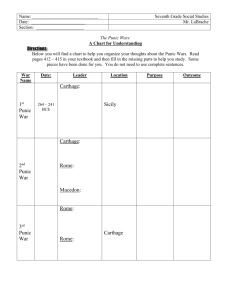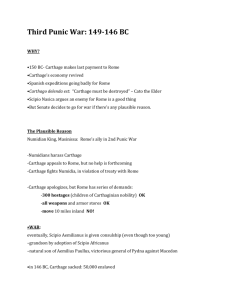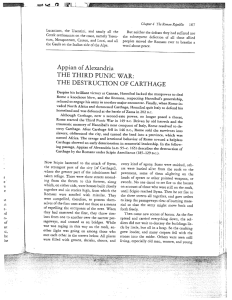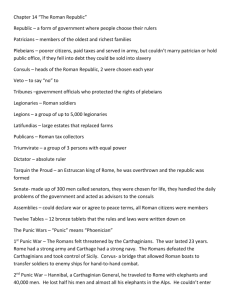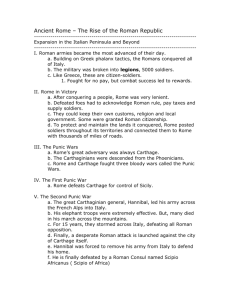First Punic War
advertisement
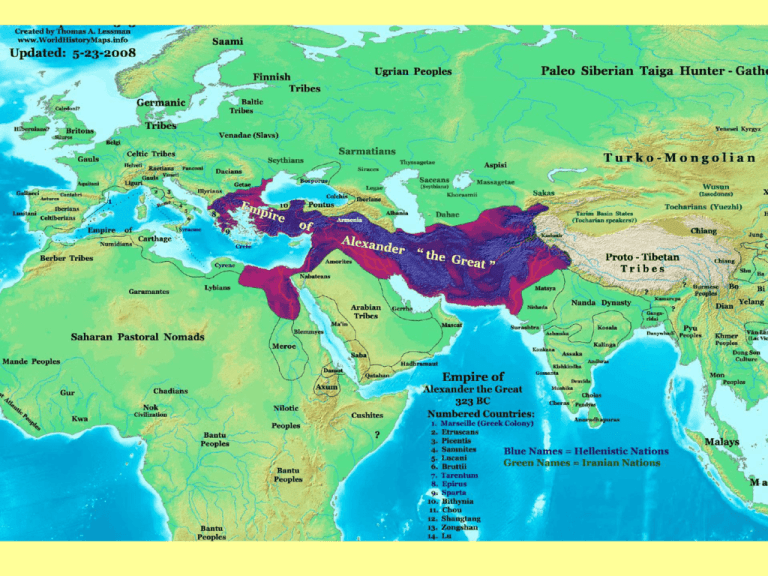
Carthage “Dido Building Carthage, or the Rise of the Carthaginian Empire,” J.M.W. Turner (1815) Carthage: Political Structure • • • • • aristocratic society council of 30 nobles (~Roman magistrates) senate (~Roman senate) 2 suffetes (~Roman consuls, but civilian only) board of generals (~Roman consuls, but military only) • 104 judges from ruling families (~Roman praetors) • citizen assembly with property requirements for membership (~Roman Comitia Centuriata) 265: Eve of First Punic War •Mamertini: take Messana, threaten Syracuse under King Hiero, who blockades Messana •Mamertini: appeal to Carthage •Carthage: seizes Messana, breaking Hiero’s blockade •Mamertini: appeal to Rome •Rome: Comitia Centuriata, guided by consul Appius Claudius Caudex ("the tree trunk"), declares war 264: First Punic War begins • Carthage: fearful of Roman interests, allies with King Hiero! • Rome: sides with the Mamertini & declares war on Carthage and Syracuse • 264-241: war on land and sea, from Sicily to North Africa • Greatest assets: – Carthage: superior technology and tactics – Rome: superior manpower and discipline First Punic War: basics • Where: Sicily and N. Africa • Naval technological change: Rome captures a Punic quinquereme (50 oars) in 261; adoption of the “raven” (corvus). Builds 100+ ships. • Epic battles: 50,000 infantry, 70,000 sailors each State-of-the-art technology: “raven” (corvus) As [the Romans’] ships were ill-built and slow in their movements, someone suggested to them as a help in fighting the engines which afterwards came to be called "ravens” (sg. corvus, pl. corvi). They were constructed as follows: On the prow stood a round pole … with a pulley at the summit and round it was put a gangway made of cross planks attached by nails …. At [the pole’s] extremity was fastened an iron object like a pestle pointed at one end and with a ring at the other end … [and] a rope with which, when the ship charged an enemy, they raised the ravens by means of the pulley on the pole and let them down on the enemy's deck, sometimes from the prow and sometimes bringing them round when the ships collided broadsides. Once the ravens were fixed in the planks of the enemy's deck and grappled the ships together, if they were broadside on, they boarded from all directions but if they charged with the prow, they attacked by passing over the gangway of the raven itself two abreast. [At the battle of Mylae in 260,] when the ships that came into collision were in every case held fast by the machines, and the Roman crews boarded by means of the ravens and attacked them hand to hand on deck … some of the Carthaginians were cut down and others surrendered from dismay at what was happening, the battle having become just like a fight on land (Polybius 1.22-23). 260 254 249 ] -241 262 256 263 First Punic War: key moments •263: Rome invades Syracuse; allies with Hiero •262: Rome defeats Carthage at Agrigentum •261: Rome captures a Carthaginian quinquereme •260: Rome defeats Carthage at Mylae, capturing 44 ships & 10,000 men •256: Rome defeats Carthage at Ecnomus (abandons corvus due to excessive prow-weight and/or instability) •255: Carthage defeats Roman expeditionary force under Marcus Atilius Regulus at Tunis; Spartan mercenary Xanthippus teaches tactics to Carthage •255: Rome loses ships in storm •254: Rome seizes Panormus •249: Carthage defeats Publius Clodius Pulcher at Drepana & Pulcher exiled for sacrilege; Hamilcar Barca, father of Hannibal, defeats Rome which loses fleet in storm •242: Rome builds 200 ships at expense of wealthy •241: Rome defeats Carthage at Aegates Islands, captures Lilybaeum, isolates Hamilcar •241: Carthage sues for peace First Punic War: resolution • Terms: Carthage loses Sicily, Corsica, Sardinia and pays indemnity of 4400 Talents (= 275,000 pounds) of silver, most to be paid over 20 years • Losses for Rome: thousands of men, 700 ships • Losses for Carthage: mineral resources of Sardinia, fertile lands of Sicily, strategic value of all three islands • Carthage's goals in 1st Punic War: attrition • Rome's goals in 1st Punic War: expansion First Punic War: analysis • Why Rome won: abundant manpower, bold action, a willingness to learn the enemy’s game • Why Carthage lost: economy of effort, lack of trustworthy manpower, half-hearted measures • Results for Rome: wider field of Mediterranean politics, reaping the benefits & profits of empire and a navy to dominate the west • Results for Carthage: diminished naval power and a hunger for vengeance
